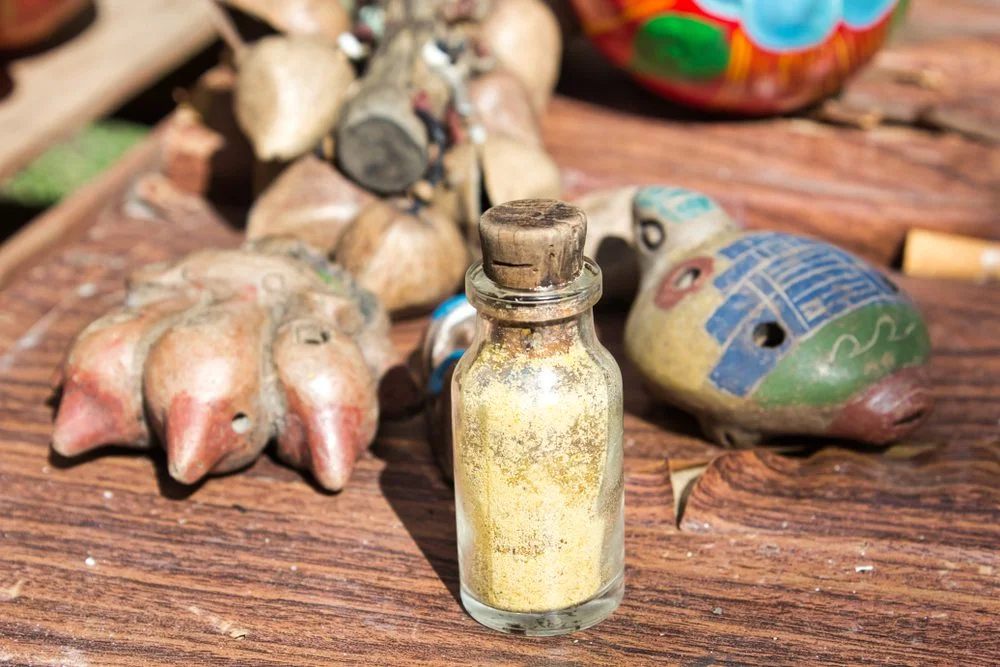Bath Salts
“Bath salts” is the colloquial term for synthetic cathinones, a class of designer drug. Comprising laboratory-made chemicals, these synthetic cathinones affect the central nervous system in a way that’s similar to other stimulants like methamphetamine, methylenedioxymethamphetamine (MDMA/molly/ecstasy), and cocaine.

Other Names: Research Chemicals, Glass Cleaner, Plant Food, Bliss, Cloud Nine, Blue Silk, Drone, Energy-1, Lunar Wave, Purple Wave, Ivory Wave, Ocean Burst, Meow Meow, Stardust, Vanilla Sky, Red Dove, White Lightning, White Knight
These drugs are often illicitly labeled “not for human consumption” to evade law enforcement and the provisions of the Controlled Substance Analogue Enforcement Act.
The United States Synthetic Drug Abuse Prevention Act, or SDAPA, restricts several forms of synthetic cathinones as Schedule I drugs. This means that they have no accepted medical use within the country and are acknowledged as having high potential for abuse.2
The law currently covers cannabimimetic agents (synthetic drugs that are cannabinoid receptor 1 agonists), the synthetic cathinone compounds mephedrone and methylenedioxypyrovalerone (MDPV), and synthetic hallucinogens. There are other synthetic cathinones that were once under the temporary control of the US Drug Enforcement Agency, and are now under permanent control of the same group.1
Why Do People Abuse Bath Salts?
People engage in synthetic cathinone or bath salts abuse for the drugs’ stimulating effects.Users experience feelings of alertness, excitement, or euphoria when they take it.
Bath salts are also actively marketed as cheaper alternatives to other illegal drugs like ecstasy and cocaine. In some cases, they are substituted for real cocaine or MDMA so that dealers can acquire a higher profit from unsuspecting drug users.
How Are Bath Salts Abused?
Most synthetic cathinones come in the form of white or brown powders, but they can also be sold as small, solid rocks or crystals. When they are sold by dealers on the web or on the streets, they are covertly advertised as either “bath salts,” “plant food,” “jewelry cleaner,” “phone screen cleaner,” or a product that’s “not for human consumption.”
Bath salts are typically abused in one of three ways:
- Oral ingestion in either pill or capsule form
- Inhaling or snorting
- Injection directly into the bloodstream
The great danger about the bath salts market is that there is no way to test the exact formulation of a batch of drugs, or how potent the drugs will be when they’re taken.
Drugs That Interact with Bath Salts
Research is still being done about polydrug use that involves bath salts. However, adverse drug reactions have been observed when people combine synthetic cathinones with the following:
- Ethanol. Mixing synthetic cathinones with alcohol can induce nausea and vomiting.
- Cannabinoids. Like with alcohol, combining bath salts with cannabis can induce feelings of nausea and the urge to vomit, which can further lead to dehydration.
- Amphetamines. When bath salts are taken with amphetamines like crystal meth or ecstasy, the user incurs a serious risk of cardiovascular problems. They can also go into a state of substance-induced psychosis or lose touch with reality.
- Antidepressants. Studies have also shown that using synthetic cathinones with prescription drugs, like antidepressants, can either increase the synthetic cathinones’ toxicity or decrease the therapeutic efficacy of the prescribed medicine.
Immediate Effects of Taking Bath Salts
Synthetic cathinones or bath salts affect people differently based on the strength of the drug involved, how much of it is taken, what the person’s health condition is like, and which other drugs were abused at the same time.
Common physical side effects of taking synthetic cathinones include:
- Dilated pupils
- Blurry vision
- Energetic behavior
- Increased sex drive
- Restlessness
- Muscle tension in the face and jaw
- Lightheadedness
- Dizziness
- Loss of memory
- Dry mouth or thirst
- Excessive sweating
- Reduced appetite
- Stomachache
- Nausea
- Vomiting
- Nosebleeds
- Rashes
- Chest pain
- Irregular heartbeat
The following psychological effects have also been observed in people who take bath salts:
- Confusion
- Anxiety
- Psychosis
- Aggressive behavior
- Violent behavior
- Self-destructive behavior
Long-Term Effects of Taking Bath Salts
Chronic users of bath salts may also suffer from these long-term effects to their health as a consequence of taking these drugs:
- Hypertension
- Hyperthermia (abnormally high body temperature)
- Breakdown of muscle fibers
- Chronic headaches
- Palpitations
- Tremors
- Excessive sweating
- Trouble sleeping
- Enduring feelings of paranoia
- Hallucinations
- Brain swelling
- Risk of liver failure
- Risk of heart attack
Symptoms of Overdose from Bath Salts
Man-made cathinones like mephedrone, butylone, and MDPV have been known to cause death by overdose. Snorting and needle injection seem to be the most harmful methods of taking bath salts and are the most likely methods to be involved in synthetic cathinone overdose.4
The following signs have been observed in patients who required extensive medical care from emergency departments or poison centers and may be indicative of an overdose on synthetic cathinones or bath salts:
- Agitation
- Psychosis
- Display of violent or aggressive behavior
- Ischemic colitis (inflammation of the large intestine)
- Myocarditis (inflammation of the heart muscle)
- Tachycardia (rapid heart rate)
- Shortness of breath
- Seizures
- Coma
Signs of Addiction to Bath Salts
The implications of abuse of synthetic cathinones or bath salts are still being studied closely by researchers. However, the Diagnostic and Statistical Manual of Mental Disorders, Fifth Edition (DSM-5) offers 11 general criteria for diagnosing substance use disorders that should also be applicable to bath salts addiction. These 11 criteria are the following:
- Using larger amounts of bath salts or using bath salts for longer than intended
- Wanting to cut down on using bath salts, but not being able to
- Spending increasing amounts of time buying bath salts, using bath salts, or recovering from using bath salts
- Having strong cravings for bath salts
- Failing to keep personal commitments or to manage personal responsibilities because of bath salts use
- Continuing to use bath salts despite problems in personal relationships
- Abandoning hobbies or personal interests because of bath salt use
- Continuing use of bath salts even when it puts one in danger
- Continuing use of bath salts in spite of worsening physical or psychological problems
- Developing a tolerance to bath salts, or needing more of the substance to get the same effect as before
- Developing withdrawal symptoms upon suddenly stopping use of bath salts
Symptoms of Withdrawal from Bath Salts
Whether or not a specific physical withdrawal syndrome can be associated with bath salts use is still being investigated by researchers, current literature notes the following symptoms to be some of the most common among those who stop using the drug:
- Cravings to continue using bath salts (in at least 25% of patents)
- Feelings of depression
- Feelings of anxiety
It should be noted that dependence on bath salts is not the same thing as addiction to bath salts. Actual substance use disorder would be characterized by compulsive use of the drug despite its harmful effects, while dependence on the substance would simply mean that a person’s body has gotten used to functioning with the drug in their system.
Detoxification from Bath Salts
The actual severity of bath salts withdrawal will depend on the user’s health situation and the amount of synthetic cathinones in their system. In any case, it is necessary to undergo medically assisted detoxification in order to mitigate the physically taxing and mentally distressing impact withdrawal syndrome might have.
If you are experiencing bath salts withdrawal and need to undergo detox, you can expect the following when you sign up for a detox program:
- Your doctor will formulate a treatment plan to slowly taper your body off the drug.
- You will be monitored by a medical team to assess your specific situation and the severity of your symptoms.
- You may receive support medication in order to treat accompanying symptoms, for example benzodiazepines to control seizures or normalize your sleeping patterns.
- You will be provided with a safe environment and requisite medical care to get through the worst of your withdrawal symptoms without incurring additional harm to your body.
Getting Treated for Bath Salts Addiction
The three principles for treating bath salts addiction are abstinence from the drug, preventing a relapse of drug use, and rehabilitation of the body and mind after the toll that the addiction has taken. Treatment will consist of pharmacological interventions and behavioral interventions that are tailored to each patient’s needs.
There are currently no US Food and Drug Administration-approved medicines for treating addiction to bath salts, but a pharmacological approach to treatment can involve medicines for co-occurring health conditions. Medical staff will pay particular attention to address polydrug usage and any existing mental health problems in the patient, like manic depression or another behavioral disorder.
Someone recovering from bath salts addiction will also benefit from behavioral treatments, like contingency management, cognitive behavioral therapy, motivational enhancement therapy, and counseling. Altogether, the behavioral treatments can help a patient identify their triggers for using bath salts, establish control over their habits, repair their personal relationships affected by their drug use, and prepare for a return to sober and healthy living.
Bath salts addiction will typically be treated either at an inpatient or an outpatient setup. Patients can expect the following from these treatment options:
- Outpatient bath salts addiction care. This is the option that is best for you if you have a mild bath salts addiction and are considered at low risk of non-compliance to treatment protocols. If you enroll in an outpatient treatment program, you will only need to go to the facility to have tests and checkups done, to receive medication, and to attend therapy. Otherwise, you will be able to stay at home and attend work or school for the duration of your treatment program.
- Inpatient bath salts addiction care. Inpatient care is the best option if you have a moderate to severe case of bath salts addiction, if you are considered at high-risk of non-compliance to required treatment, or if you have a history of non-compliance during your previous treatment program. This arrangement will require you to live inside a facility for the duration of your treatment so that you can receive the intensive and round-the-clock medical care needed for your recovery.
Get Treatment for Bath Salts Addiction Now
It’s never too late to fight back against synthetic cathinones abuse and to regain control of your life. If you’re currently battling an addiction to bath salts, don’t delay getting immediate care to treat your condition.
Start your journey toward a full recovery from substance use disorder with the help of Better Addiction Care. Call us at (800) 429-7690 to speak with one of our trained recovery support advisors. We’ll be happy to assist you in finding a local treatment center, and we can also verify your insurance plan for either an inpatient treatment program or an outpatient treatment program. If you don’t have insurance at the moment, we can still help you find the right financing options for your situation.
A Short History of Bath Salts
Cathinone is a naturally occurring substance that comes from the khat plant or Catha edulis, a shrub that’s native to the East African region and on the Arabian peninsula. For centuries, khat leaves have been chewed in order to achieve a stimulating effect. But the earliest report of a synthetic cathinone synthesis was recorded in 1929. To date, there are about 30 synthetic cathinones known to science.
Though recreational abuse of synthetic cathinones began in the 20th century, the widespread manufacturing and abuse of the drug that is now considered a major health problem in the United States began in the 2000s.








